|
|
| RHP |
South African
River Health Programme
|
State of the Rivers Report
uMngeni River and Neighbouring Rivers and Streams
|
DAMS AND URBAN RIVERS: IMPACTS NEEDING SPECIAL ATTENTION
|
|
DAMS AND RIVER HEALTH
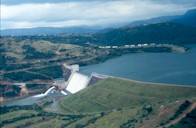
|
The rivers of the uMngeni and uMlazi catchments are heavily regulated by large dams, weirs and smaller farm dams that capture water to provide drinking water and water for irrigating crops. These rivers are also under pressure purely through the large and dense human population in the area that depends on the products and services that these rivers provide. Dams and urban development have a significant influence on the health of these rivers.
|
|
There are 129 registered dams in the uMngeni and uMsunduze catchments. Five of these dams can be considered large, namely Midmar, Albert Falls, Nagle, Henley and Inanda. Together these dams have a capacity of 753 million cubic metres of water, more than the mean annual runoff for the entire catchment (740 million cubic metres). Dams provide storage capacity for water, contain floods and provide sites for recreation activities. But they also cause river health problems.
Problems include:
All the dams on the uMngeni River were built mainly for water supply, and are not managed to accommodate downstream ecological needs. As a result, rivers downstream of dams shrink and have altered habitat. This may result in diminished availability of useful benefits (e.g. less fish and reeds).
Dams trap sediments and nutrients, resulting in the release of cleaner 'high-energy' water downstream. This water erodes sediments from the river. Very clean water may also alter faunal composition because clearer water favours predators that use sight to hunt their prey, for example bass, while yellowfish are well adapted to turbid water.
Water released from dams generate downstream flows that are unnatural, leading to changes in the life cycle (and sometimes death of) aquatic fauna. For example a flood in mid-winter can trigger inappropriate cues for breeding and as a result, increased risk of offspring deaths.
Water spilling over a dam usually contains large numbers of algae. Algae are not typical of fast flowing and turbid rivers such as the uMngeni and introduce a new food source to the system, which results in changes in vertebrate community structure.
Water released from the bottom of the dam (e.g. Albert Falls and most of the other dams on the uMngeni River) is much colder than the river water, and contains dissolved manganese, iron, sulphur and ammonia, all of which are potentially toxic to aquatic life. Some of these problems can persist for more than 20 km downstream.
Reduced flow downstream of a dam can lead to vegetation encroachment, by reeds such as Phragmites australis and even terrestrial species, resulting in the narrowing of the river channel. This can have devastating effects in the event of large floods when the river channel can no longer transport the flood waters. Flood waters then tend to uproot plants that are swept downstream where they jam against (and sometimes damage) bridges and other infrastructure.
Dams are barriers to fish migration. Fortunately, on the uMngeni River this impact is minimal as there are only two species that migrate. Eels manage to climb most dams walls and the yellowfish will make do in suitable areas below the dams.
Dams affect the goods and services delivered by rivers, especially to people who depend on products that are directly associated with the river ecosystem. Fortunately, these impacts can be managed by releasing water from dams in a way that is compatible with downstream needs. Plans are afoot to investigate this for the uMngeni River.
|
|
URBAN RIVERS
More than 12% of the uMngeni and uMlazi catchments is formally or informally urbanised and we can expect this trend to increase in future. An urban setting and high population numbers and densities create a particular.
|
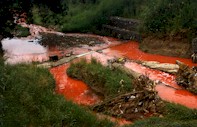
|
|
set of challenges for river health and this in turn affects the types, amount and quality of river-benefits. Increased pressure on water supply; therefore increased pressure to construct water supply infrastructure such as large dams and water transfer schemes.
Paving/hardening of large areas which alters catchment hydrology and the quality of water which returns to streams and rivers; and
Increased volume and concentration of solid, domestic, organic and industrial waste; The box below provides detail on the impacts of faecal contamination, a particularly severe problem in the uMngeni and uMlazi river systems.
|
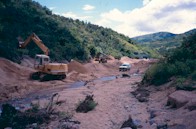
|
The impacts of urban activities on rivers are intense, but at the same time, people in urban environments need and demand much from their rivers - enough clean water for basic needs, effective waste removal as well as a river that provides for recreation activities and which is aesthetically pleasant. We need to reconcile the need for economic growth, human well-being and the continued provision of desired goods and services from rivers with in urban setting. We will need to make careful trade-offs around the costs and benefits of our activities in relation to river systems.
|
|
RIVERS AND CHOLERA
Cholera is water-borne bacterial infection associated with a lack of good quality drinking water and sanitation. Although the fatality rate was low (< 0.4%) during the 2000/01 cholera epidemic, KZN reported 116 170 cases. During the epidemic, municipal water was safe, but relying on drinking water directly from rivers and dams were especially vulnerable.
|
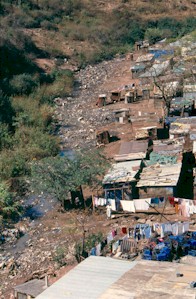
|
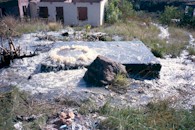
|
The prevalence of cholera is related to HIV/AIDS since people with immune systems weakened by HIV/AIDS are easily attacked by cholera, a highly opportunistic disease
|
| FAECAL CONTAMINATION AND IMPACTS OF INFORMAL SETTLEMENTS
|
|
One of the major impacts of the fast-growing informal settlements in and around Durban and Pietermaritzburg is the contamination of the streams and waterways with raw sewage. This usually happens where faecal matter is either washed from the surface of the ground, or pit latrines seep below ground and into the streams. In more developed areas, blockages cause sewers to discharge their load into the nearest river. For example, recently, in the lower uMlazi catchment, more raw sewage has entered the river than finds its way to the treatment plant!
Escherichia coli (E.coli) is a human gut bacterium. Its presence in water indicates faecal contamination. Water should be completely clear of this contaminant if the water is to be safe to drink, and even the recreation potential is negatively affected by the presence of E.coli as counts in excess of 400 counts per 100 ml (SA Guidelines) will result in a high risk. The following are some recent E.coli results illustrating that the provision of goods and services by these rivers have been compromised by poor management of human activities and infrastructure relating to faecal contamination.
Mayville Stream, a small stream between Mayville and Westridge Tennis Stadium, E.coli up to 290 000 per 100ml of water. (Cause: Informal communities - inadequate sanitation).
Bellair Stream, E.coli up to 310 000. (Cause : informal community.)
Aller River, New Germany. E.coli:up to 400 000. (Cause: informal community - inadequate sanitation).
Umhlangaan River above Kwamashu waste water works. E.coli up to 240 000. (Cause: broken sewers in Kwamashu Township).
Isiphingo River above the Isipingo waste Water Treatment Works, E.coli count up to 10 000 000 and exceeding 100 000, 60% of the time. (Cause: broken sewers in uMlazi Township).
uMngeni River at Kennedy Road, E.coli up to 1 080 000. (Cause: Informal Community on the banks of the Palmiet River.) This is an example of the impact that a community on a small river can have on a larger river!
uMlazi River below Fongozi Stream, E.coli up to 720 000. (Cause: broken sewers in uMlazi township).
The Slangspruit just above Pietermaritzburg and the Baynespruit within the City boundaries, have recently contained E.coli counts of 670 000 and 610 000 per 100 ml respectively.
|
|